
I never really know what to expect when I walk into the home of someone I am about to interview. Sometimes, things are very simple, the interview is easy and straight to the point. I get to know them, take a bunch of photos, give them a hug goodbye, and that is the end of it.
Other times, things don’t go as smoothly, things get messy, emotional, and I leave feeling emotionally drained. That is what happened when I went to interview the talented artist that is Alan Walker.
A few weeks ago, Alan sent me an email with photos of some of his paintings for an art show I was helping curate. I emailed back and asked if he would let me interview him.
He invited me to his family home off of West Side Ave where he’s lived for many years with his wife and kid. He took us to his basement where he paints, and we sat down to chat and look at his work.
Within a few minutes, we started talking about his childhood and he opened up to me about his complicated and very sad relationship with his father. I wanted to cry. I immediately embraced him and tried to console him. I was at a loss for words. I felt his pain.
Alan is a true talent, and it opened my eyes to the complexities of the human spirit. That you really never know what’s going inside of someone who is so gifted. I’m not sure Alan even knows how talented and amazing he really is. I want to give him a big hug.
Alan, if you’re reading this. You’re awesome and very loved.
What’s your name?
My name is Alan Walker.
What do you do?
I’m a painter.
Is that what you do for a living, as well?
Yes. It’s complicated, but essentially, yes.
Not a lot of people can say that.
Right. That’s why it’s complicated. It’s not the whole truth, but it’s part of the truth. I don’t have any other employment, except for the gig at a junkyard.
How long have you been painting?
I’ve thought of myself as an artist since I was a very small child. I liked to draw right away. I’ve been painting with the idea that I was going to do it as a serious thing since I was in high school. There are some paintings around here from that period. As an artist, I’ve ended up doing a lot of things, including working on movies and commercials to build sets and be a scenic artist. I worked at the Museum of Natural History for twenty years and ten days being involved with building the exhibits and things like that.
That’s awesome. Can you tell me about your style of painting?
I’m a scene painter. The colors I use have sometimes been referred to as somewhat Fauvist, which is from the early 20th century, right before Cubism. I have branched out. I work from my own photographs and usually take multiple pictures. If I know what something is, it’s easier to describe. I like really telling the story as best I can through the paint.
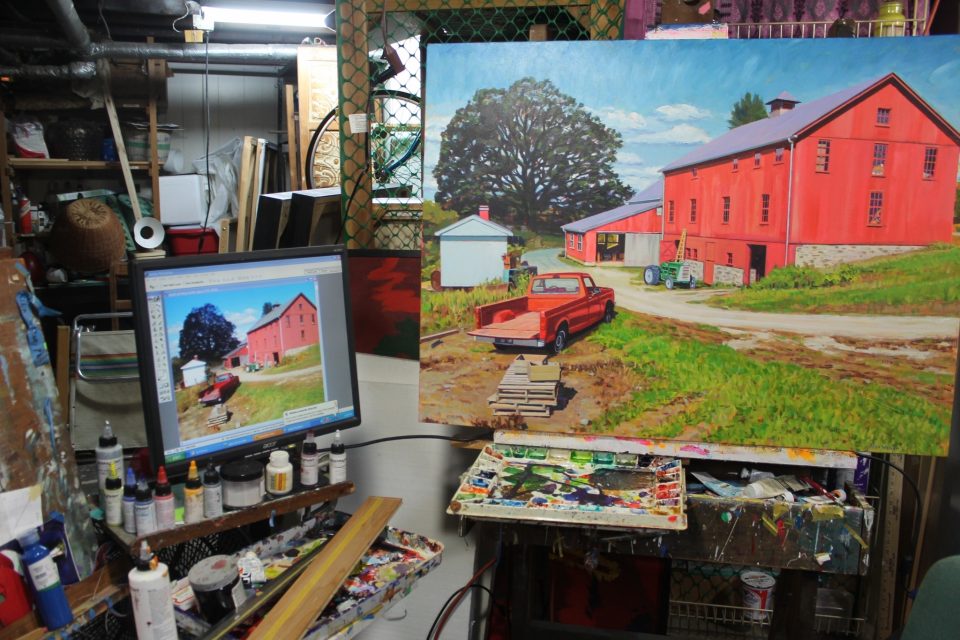
Where was this photo taken?
It was in Connecticut. My mom used to live in coastal Connecticut, so we’d go up there all the time, and this was the day of apple-picking.
Beautiful.
I rebel against the notion of working from photographs. Sometimes, one of these paintings will take me often two months of working on it almost every day. I started this painting two years ago, almost to the day. I laid it out and didn’t work on it. I was sick of doing landscapes and scenes, so I did some portraits for a while and a bunch of abstract that were all geometric. I did a show’s worth of these.
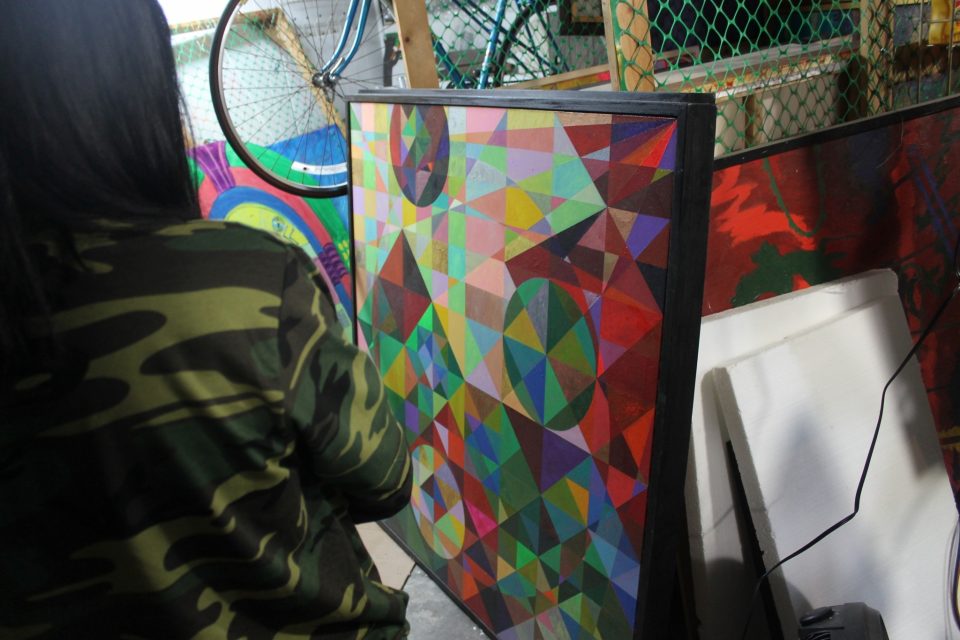
This is all a process. When you paint a picture of a thing, you have the thing to start with. I’ve always admired artists who have a process where they don’t have to have a thing to start, they just start, and it develops. I started doing a series of paintings all based on grids. I like to improvise more than I like to rehearse the same thing over and over again. These are improvisations. I started with a grid and the idea developed from there. I did these for a year and a half.
It’s so structured. I can’t explain it, but it’s very interesting.
I became really interested when I got this great book while looking for something for my daughter for Christmas – Infinite Measure. It was right when I started working on the grid. It shows how to plot geometrically all these forms. I became completely fascinated. I can figure out the tip on a check at a restaurant, but math is not my favorite thing, so the equations don’t mean anything to me. Visually, it was appealing.
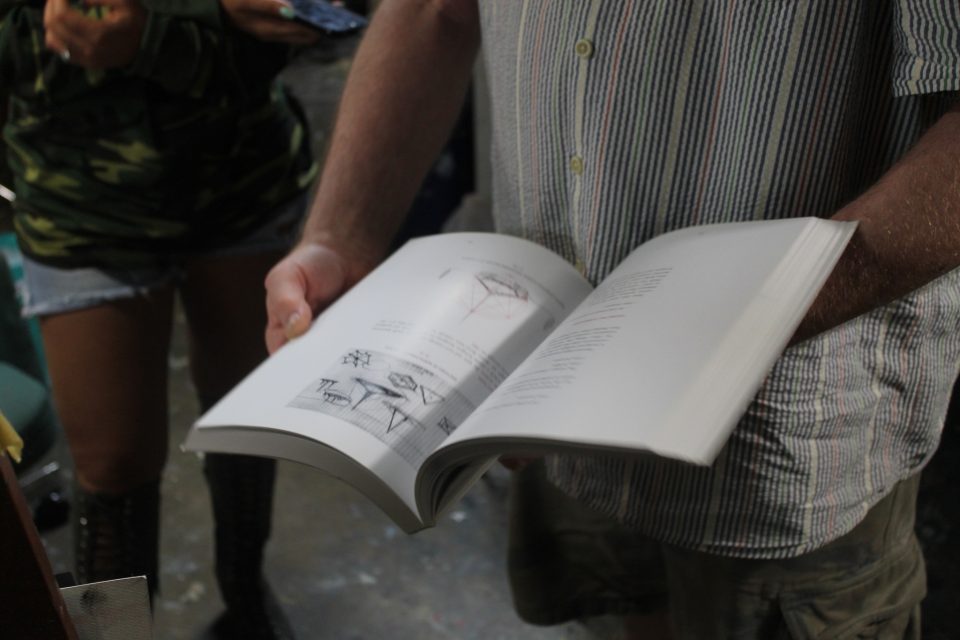
In order to make them, I decided I needed a really big compass, so I made one. None of the rulers were long enough for the larger canvases, so I made my own ruler because it needed to be long enough to go diagonally across the canvas. I just needed a process. Sometimes, I don’t find a subject that I’m in love with, so I’m stuck. What happens then is I pick something that I could maybe make into a good painting, but that never happens. If it’s not a good, strong picture, to begin with, it makes a bad painting.
What inspires you? What sort of photographs are you mostly attracted to that make you want to create a painting?
I love color. It’s also compositions. For instance, in this photo, I just came upon the scene. I love the red barn because it’s nice, big graphic shapes. Then there’s a red truck here, and those were really stacked like that. It’s all about the composition. I love this road that goes in front of the truck, and you can see it goes into a shadow around there, and then it’s up here again. For me, this photo tells a story, like those crates are going to get loaded into the back of the truck and drive around there. Using color to describe the shadows and the depth, and having the road go around the corner, this is like being a musician and having a part that’s really fun to play. Having things like this are fun to work with.
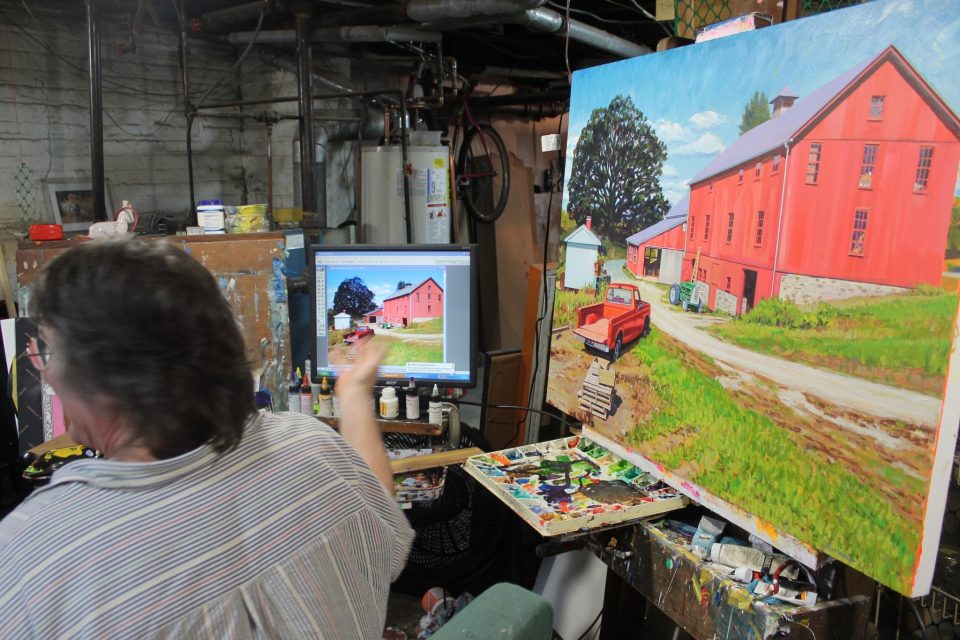
So I remember when you emailed me a series of photos of yourself as a boy. Can you talk to me more about that?
I received from my mother recently the family slide archives. My family wasn’t close. My parents split a long time ago. Most of these pictures were taken with things written on the boxes, and we never watched them. It’s not like people came over and said, “Let’s watch our family slides.” I hadn’t really seen most of them. I started going through them, and I found that I’d been heavily documented in the early part of my life –for the first ten years, which was about the time I started not being close with my parents as I headed into my teens and our relationship became more and more difficult. I was surprised at how many pictures there were of me and how good they looked. These are two and a quarter. For most of them, the color hasn’t stayed very good.
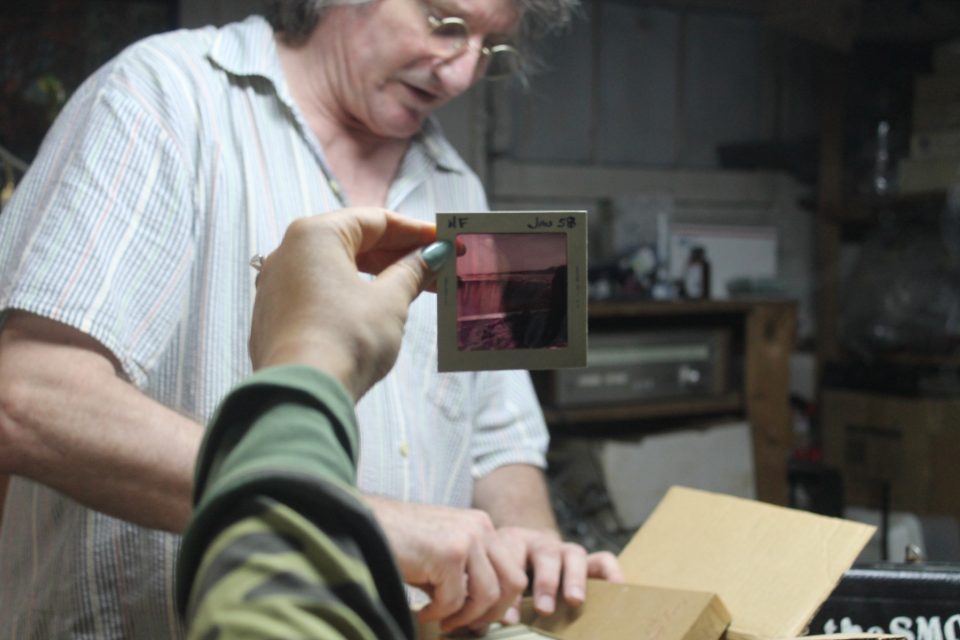
That’s Niagara Falls.
That’s amazing.
I started going through the slides, and it’s an ongoing project to scan them and see what’s there.
The first portrait I did was of my daughter. I happened to get a picture of her the first time she wanted to go thrift shopping. We were by my mom’s in Connecticut, and we went to the Goodwill there. There are some wealthy neighborhoods, so they had high-end suits there for $20 and things like that. She wanted to wear something to her middle school prom, so she came out of the dressing room and had this dress on. She suddenly looked like a young woman, and all of our jaws dropped. So I took a picture with my phone and then painted the portrait. These photos showed up around the same time.
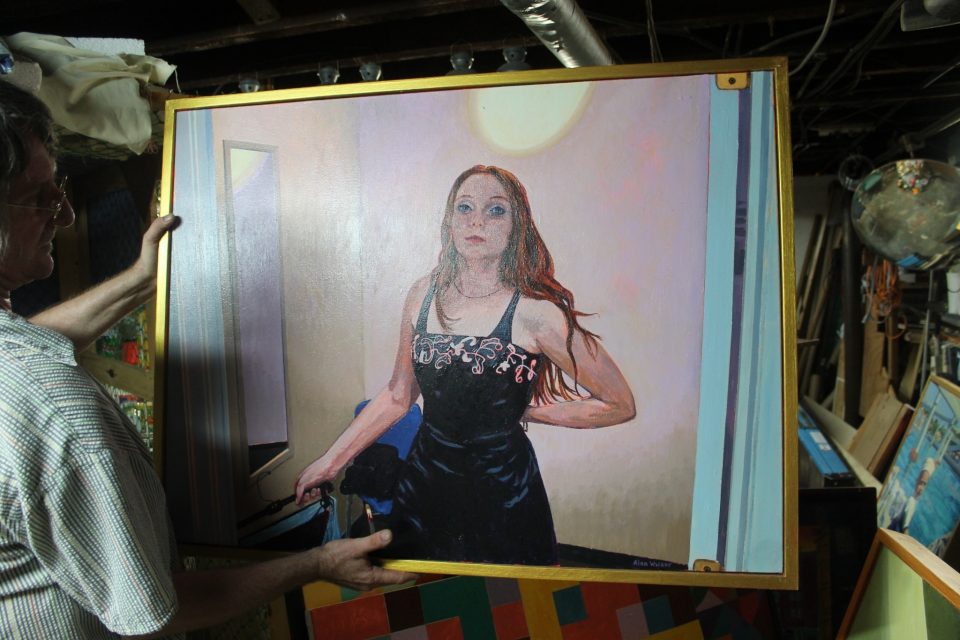
In most of my pictures, there aren’t people in them. It’s not that I can’t paint people, it’s that I don’t choose to have them in here. I became interested in doing portraits because I didn’t want to do landscapes for a while. The next one I’m going to do is already started. I started this two years ago.
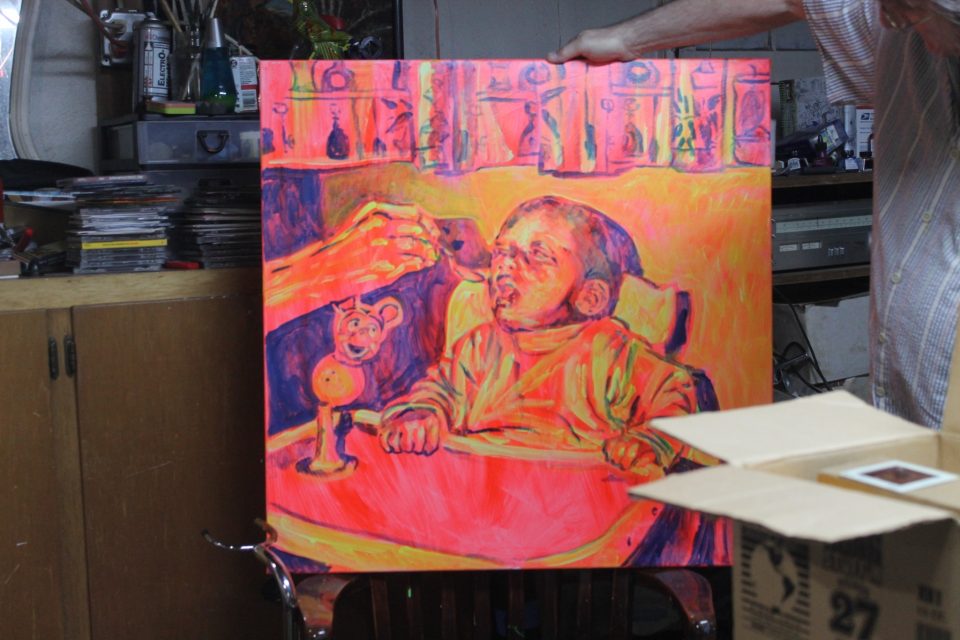
This is how I lay them out. This is the first layer, and then I paint over all of this.
That’s amazing. Do you have another one of these, later in the process?
Oh yeah, they’re all stored here.
So talk to me a little bit about painting your childhood self. How was that? It sounds like you found a lot of new memories.
Here’s a perfect example –
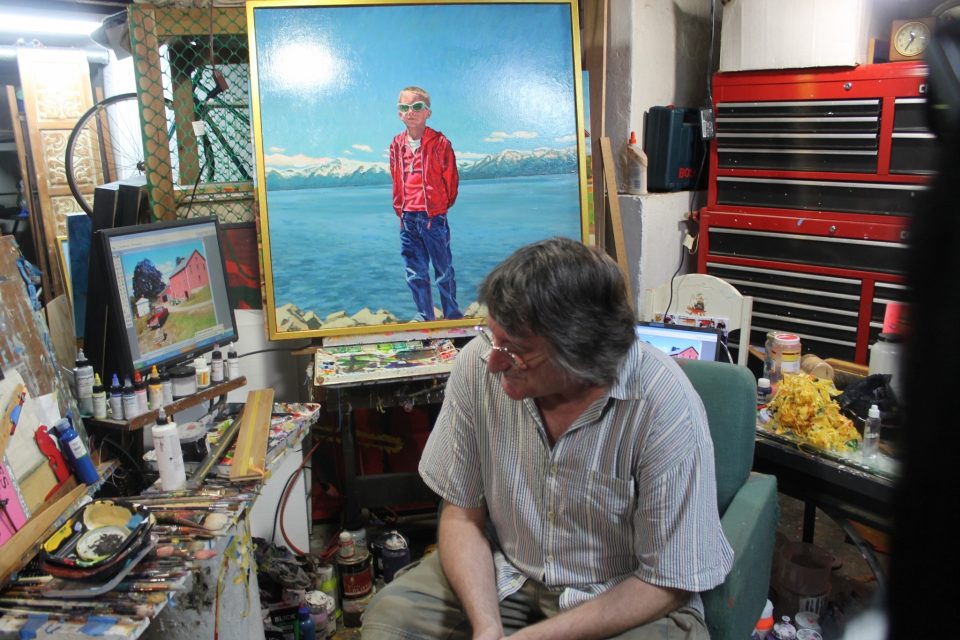
Oh, wow. That is amazing! How old were you in this photo?
I can pinpoint this – I was six. I was about to go into first grade. While painting these things, I knew that this was Lake Tahoe and the memories would come back in ways that were remarkable. What I remember about this day is that I was in the back seat of the 1961 Corvair we had on this family trip. I had Dr. Seuss’ Hop on Pop and my mother had taught me how to sound out words, so I was in the back seat of the car reading out loud for the first time. We stopped here for lunch, and it was the most amazing thing I’d ever seen. Lake Tahoe is probably still amazing. I couldn’t believe it. I found out we were just stopping for a few minutes and we were really going somewhere else. We happened to be going to Donner Pass, and the idea of going to a place where people ate each other was not easy to explain to a six-year-old. We were here at Lake Tahoe, and I wondered why we couldn’t just stay there. So here, I am entirely pissed off at the person taking the picture.
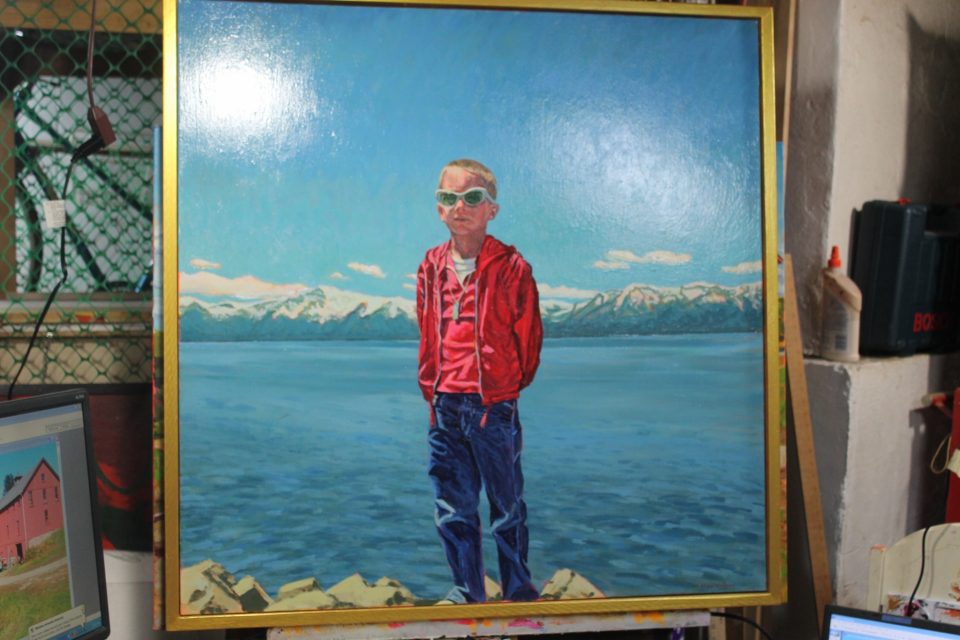
Those were my mom’s sunglasses. Even though they were women’s glasses, I liked the green lenses. I just liked them anyway, and I remember them.
How long did it take you to paint this?
It took me between one and two months. This one was simple and wasn’t particularly painful. Almost all of the portraits, when I started to think about them, I realized have really bad memories where they’re often after tears. Then my father would insist on taking the picture of me after reducing me to tears, for some reason.
Do you want to talk more about that?
We don’t talk. I don’t communicate with him. It was not a good relationship. There’s a level where I’m collaborating with my dad in these portraits because he took the pictures. It’s a form of collaboration, but he doesn’t know about them, and I’ll never tell him I did these.
How long has it been since you’ve last spoken?
Well, it had been about nine years. In the time that I didn’t speak to him, I’ve acquired a family that had a little bit more feeling, so I’ve been emailing him birthday greetings and things this last year.
Has he responded to you?
Yeah. One of the reasons I stopped communicating with him and asked him to not communicate with me is that everything he sent was like a forwarded email from his friends that were right-wing propaganda and a bunch of political stuff. It would always make me furious. I would send back, “Look, it’s totally wrong, what you’re saying.” His response would be, “Well, I don’t care, I want to think that it’s right. I like thinking this.” So as soon as I started sending him something, he’d immediately send a political and I’d write back reminding him that he wasn’t allowed to do this.
I think what really shapes an artist is life experiences, and I think it’s important to get people to understand you better. Do you want to talk more about that side of your life and how it’s affected your art or you as a person?
It’s real deep. It’s the kind of thing I think about but haven’t shared a lot of times. I wrote about these for the Drawing Room last year.
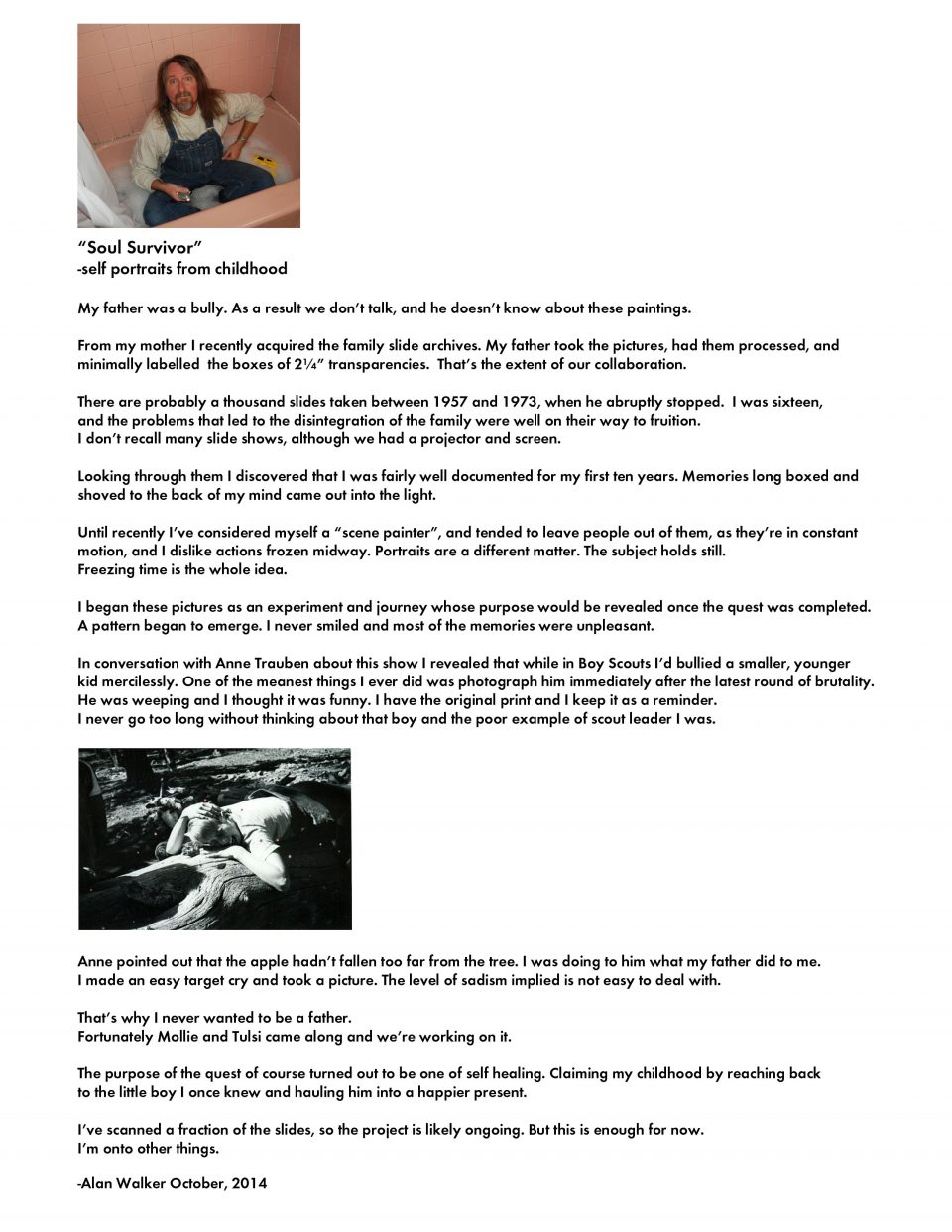
I talked about how my dad is a bully. Like in this picture – this is Disneyland.
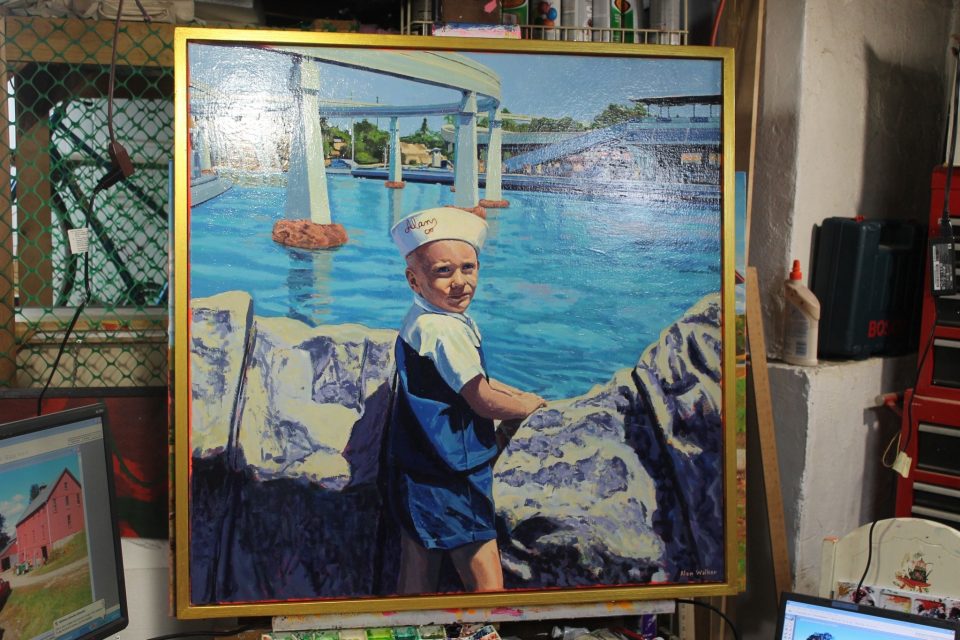
What I remembered about this was that this is the first time I went to Disneyland. The submarine ride was new and Disneyland itself had only been open for five or six years. My dad was in the Navy, and we went on this submarine ride. I loved it so much and my dad said that he was on submarines, so I said, “I’ve been on a submarine!” He said, “No you weren’t, those don’t even go underwater. It’s totally fake.” I burst into tears, and that’s why he had to buy me the sailor hat. The only way I could get the hat was by him making me cry first. This picture is taken where we walked around where you can see that it’s obviously fake and there’s tracks under the water. You can see that the submarines just go through a cave as a transition and come around, but they’re above water. Then he takes the picture after that. Him sending me the political things strikes me as abusive, too. It’s mostly psychologically abusive and emotionally abusive. Less physical, but there was that, too.
These were quite a journey. I call this one “Soul Survivor,” and that’s what I called the show, too.
I can see the pain in your eyes in this photo.
Yeah, I realized I’m hardly smiling in any of the pictures.
Has he ever seen your work?
He has.

I like this one, too. This picture needed something on the top, which I usually don’t add. I did this right after Sandy Hook. This needed something, so I put “Dead or Alive” because it was better than “Wanted,” which that would’ve suggested that our relationship was better. I was sleeping, so I guess he came in with the flash and took a picture of me. I knew I need to paint this because it was too good. My dad and I collaborated.
My father mostly taught me to just get a job and give up your dreams. I spent quite a bit of effort trying to please him, and then at some point, I decided to stop. A couple of times over the course of my adult life, I’ve let him in and out. It always gets back to that. If we could have a different relationship, I’ll have one, but it gets back to that, and I say, “No, I’m not going to have this. This is abusive.”
It seems like the relationship with your father is still very intense in your life, even after so many years.
Yeah. There’s a lot of anger and hurt involved. For me, art has always been something he couldn’t take away from me. There’s no amount of verbal abuse or lack of support that could take the art away for me. It’s really been the center of all of this. It comes from a deep place, so at least I’m expressing that.
It’s important for people to understand that, with great talent like yourself, it comes from a place of pain and hurt.
The gift is a burden, too.
I tend to leave people out of my pictures because, as soon as there’s a person in it, it’s entirely frozen in that one moment. I’m more interested in the scenes.
Your picture looks exactly like the photo, though. It’s amazing.
It’s all about colors for me. That’s why I paint – I like playing with the color. It’s learning how to interpret and see what’s there in the picture, and try to reproduce by getting what is going on in the colors. Everything is like a math problem here. The sky is one color, which makes the shadows a complementary color on the other side of the color wheel. The roof is tin, so it doesn’t have a color, but it’s reflecting the sky. It’s all about figuring out what the colors are when combined.

I have a lot of different paints. I just learned this technique with acrylic paint: put strips of paper towel down, keep it moist, and the paint lasts for weeks instead of pouring out paint that dries that day.
So how long have you been in Jersey City?
I moved here in 1994. I was born in Buffalo, NY but I grew up in California.
How did you get to Jersey City?
My parents split up, and my mom decided to move to Florida, where her brother and other family lived. I decided I was sick of California, and it was a good opportunity for me to move to NY. I went to New York in 1981 as a tourist, and I fell in love with the city. It took me eight years from that time of seeing it get there. I moved to Florida to get my stuff across the country, and then I moved to North Carolina to visit friends from college. I worked on movies for a while and made some money; then I moved to New York August of 1988. I was sick of rent going up for the same crappy apartment, so I moved to Long Island City in Queens. From there, I bought this house in Jersey City.
How do you feel Jersey City has changed in the past few years?
It’s been incredible. It’s been a slow and steady improvement but has accelerated in the last 5 or 6 years. It cracks me up when I see people I know on Facebook who are more recent than me, and they’re complaining about newcomers. Everybody’s a newcomer at some point. Yeah, it’s changing – New York isn’t even the same as when I was there. It’s all changing. I used to be envious of people who lived Downtown, but now I’m not. I still go Downtown and enjoy that it’s getting some recognition.
Do you have a favorite hangout spot?
Since I left the museum in 2009, we really don’t get out too much. I haven’t eaten at a lot of places. The coolest place is on West Side – the Park Tavern.
I love them! They have great burgers.
I’ve done a drawing of one of their burgers. I also like Madame Claude’s. I just went to their new location last week, and it’s great. Marco and Pepe used to be a place I liked, but I haven’t been there in a long time. I used to like The Kitchen, and then I just found out about that new place. I used to like going to Uncle Joe’s. We used to play there from time to time.
You’re also in a band, right?
Yes, we’re the Smoove Sailors.
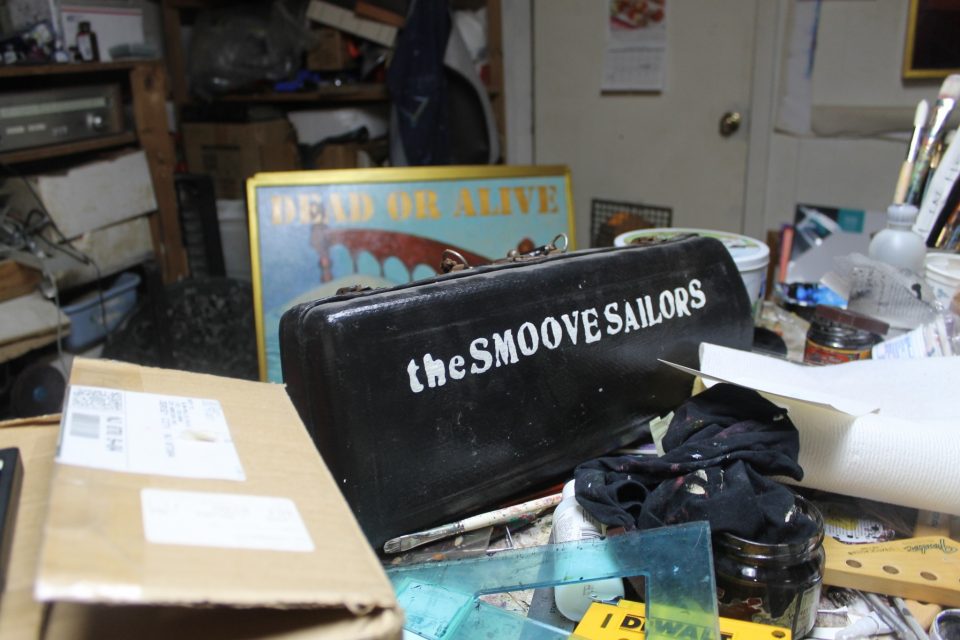
What kind of music is it?
We’re a collective of up to nine of us. Often times, it’s four to six. Sometimes we play surf music, and sometimes we play rock music. We’ll do an acoustic night, or entirely ambient. We play with different themes.
So you play an instrument?
I play mostly guitar, but I play drums and bass, too. There were too may guitar players in the band, so I’ve been playing the organ. I have a piano and an organ.
Do you have any shows coming up?
I’m waiting to hear on a couple of things, and I’m sure there’ll be something soon for the studio tour. There are several possible opportunities, and I’ll do as many of them as I can.
Are people able to purchase your work? Do you commission pieces?
Yes. I’ve done commissions, and you can see them on the site I did a portrait of a friend of mine smoking a cigarette when he was 9. He thought it was really funny. I’d love to do more!
Alan gave us a tour of his place, and it’s amazing how much artwork there is on each floor! His wife and daughter are also artists, and his daughter created a short film for an Animation course. See below for all photos, and keep up with Alan Walker on his website.


























You must be logged in to post a comment.